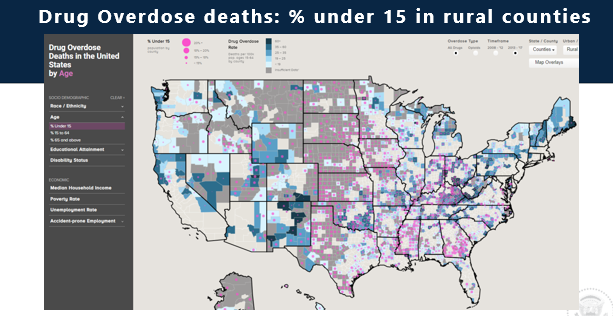Nationwide, the opioid crisis is increasing health care demands and putting pressure on law enforcement, emergency response, and social services. The issues are particularly serious in rural areas, which have high rates of poverty and unemployment, limited medical and social services, and transportation challenges. A recent Harvard School of Public Health survey found that rural Americans identify drug addiction or abuse (including opioids) and economic concerns as the two biggest problems facing their local communities.
At the September 25, 2019, meeting of the Federal Advisory Committee on Juvenile Justice (FACJJ), Betty-Ann Bryce, Special Advisor on Rural Public Health, Education and Treatment at the Office of National Drug Control Policy, highlighted new federal resources available to help rural areas. Ms. Bryce is currently on detail to ONDCP from the Department of Agriculture (USDA).
The Rural Opioid Federal Interagency Working Group, chaired by ONDCP and USDA, has produced a guide titled Federal Resources for Rural Communities to Help Address Substance Use Disorder
and Opioid Misuse. The guide offers a “one-stop-shop” listing for rural leaders seeking federal funding and partnership opportunities to address the opioid crisis.
 The areas highlighted in pink in the map above show national drug overdose death rates for children younger than 15. The Community Assessment Tool also provides breakdowns of these statistics by individual states and counties. In addition, the tool offers information at the national, state, and county levels for individuals ages 15–64.
The areas highlighted in pink in the map above show national drug overdose death rates for children younger than 15. The Community Assessment Tool also provides breakdowns of these statistics by individual states and counties. In addition, the tool offers information at the national, state, and county levels for individuals ages 15–64.Last year, USDA launched the Community Assessment Tool, an interactive database to help community leaders assess how and why the opioid epidemic is impacting their regions. The tool allows users to analyze drug overdose deaths according to geographic area, time frame, and socioeconomic and demographic factors such as race/ethnicity, unemployment rate, educational level, and age.
Ms. Bryce said new data will soon be added to the tool to complete the rural picture. Information will include a region’s level of broadband access, rural transit gaps, treatment centers, health professional shortage areas, and areas of persistent poverty.
The FACJJ meeting also featured a presentation
by the Office of Elementary and Secondary Education (OESE) on Department of Education programs that fund supplemental education services for youth in juvenile and adult correctional facilities, youth in residential facilities for neglected children and youth, and community day programs for neglected or delinquent youth. Supervisory Education Program Specialist Faatimah Muhammad and Program Officer Jasmine Akinsipe outlined the services available through Title I, Part D of the Elementary and Secondary Education Act.
They also discussed opportunities for partnerships with other components of the Department of Education as well as cross-system collaboration at the national, state, regional, and local levels. OESE presented on these topics in September at a meeting of the Coordinating Council on Juvenile Justice and Delinquency Prevention in Washington, DC. For more information, read “News From the Coordinating Council on Juvenile Justice and Delinquency Prevention” in this issue.
OJJDP Administrator Caren Harp presented certificates of appreciation to the FACJJ members in recognition of their dedication and service to the juvenile justice field.
The FACJJ meeting concluded with activity reports and recommendations by the heads of each of the three FACJJ subcommittees—Special Topics, Facilitating Compliance With the Juvenile Justice Reform Act, and Educating the Field.
The FACJJ meeting was held in Kansas City, MO, concurrent with the OJJDP State Relations and Assistance Division National Training Conference.
